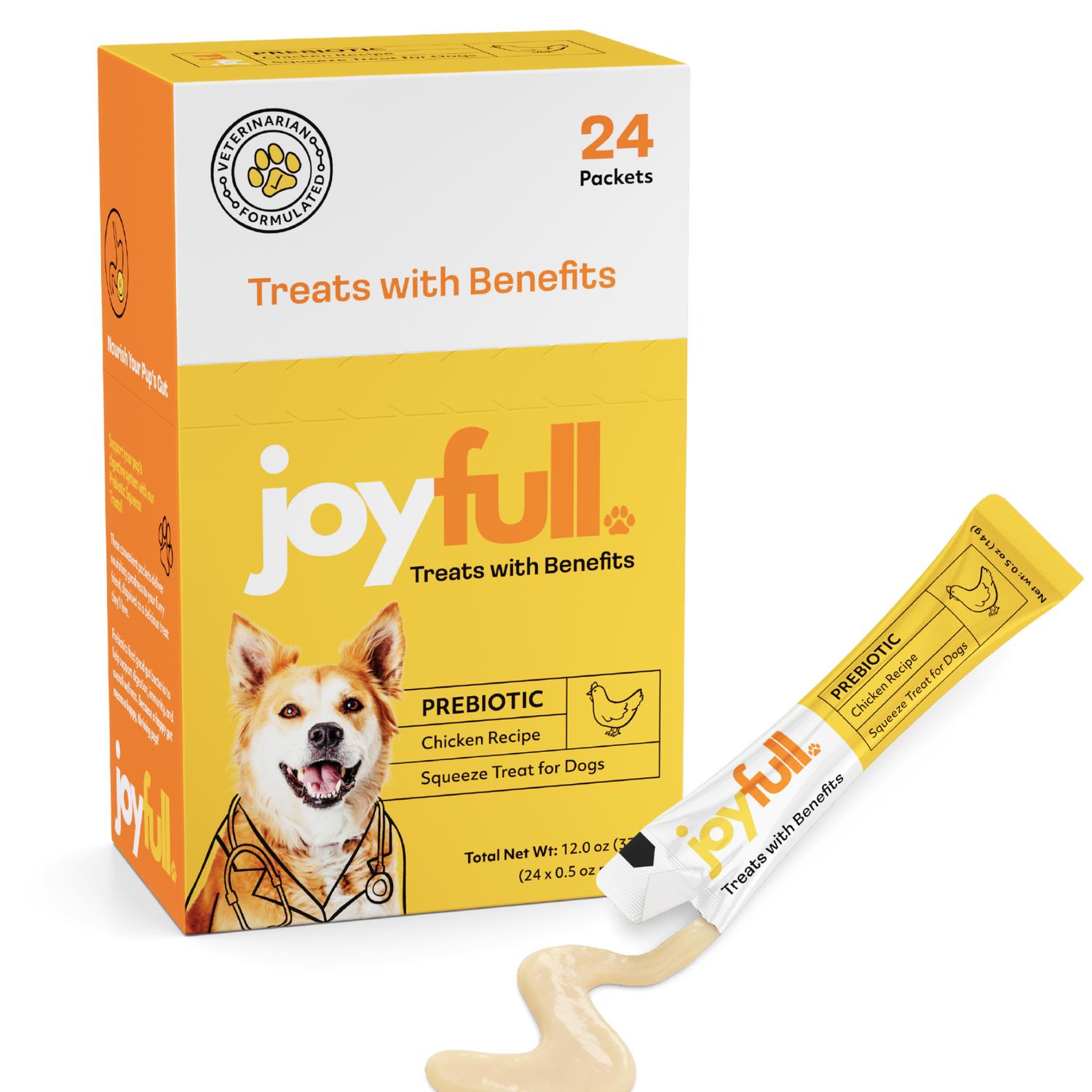
Signs of Food Allergies in Cats You Shouldn't Ignore
When your cat won't stop itching or keeps getting an upset stomach, it's easy to get frustrated. The most common signs of food allergies in cats are relentless itching and skin problems, especially around their head and neck. You might also notice ongoing digestive issues like vomiting or diarrhea.
Unlike us humans who get sniffly and sneezy, a cat's allergic reaction almost always shows up on their skin or in their gut.
Is Your Cat's Food Causing Hidden Problems?
It's a familiar story for too many cat owners: your kitty is constantly scratching, licking their fur off in patches, or dealing with chronic tummy troubles, and you just can't figure out why. You might blame it on stress or assume they ate something they shouldn't have, but the real problem could be right in their food bowl.
These persistent issues are the classic calling cards of a food allergy. And here's the tricky part: they can pop up at any age, even if your cat has been eating the same food without any problems for years.
To get to the root of it, it helps to understand the difference between an allergy and an intolerance.
- A true food allergy is an immune system overreaction. Your cat's body incorrectly flags a common protein—like chicken, fish, or beef—as a threat and goes on the attack. This immune response is what causes all that inflammation and miserable, itchy skin.
- A food intolerance is much simpler. It’s just a digestive problem. Your cat’s body can't properly break down a certain ingredient, which leads to symptoms like gas and diarrhea, but it doesn't involve the immune system.
Think of it this way: a food allergy is your cat's internal security system mistakenly sounding a five-alarm fire for a harmless protein. An intolerance is more like a simple traffic jam in their digestive tract.
Pinpointing the exact ingredient causing the reaction is the only way to bring your cat some relief. While you're figuring it out, learning how to choose cat food can give you a head start on finding a diet that will keep them happy and healthy.
Decoding Your Cat's Skin and Coat Symptoms
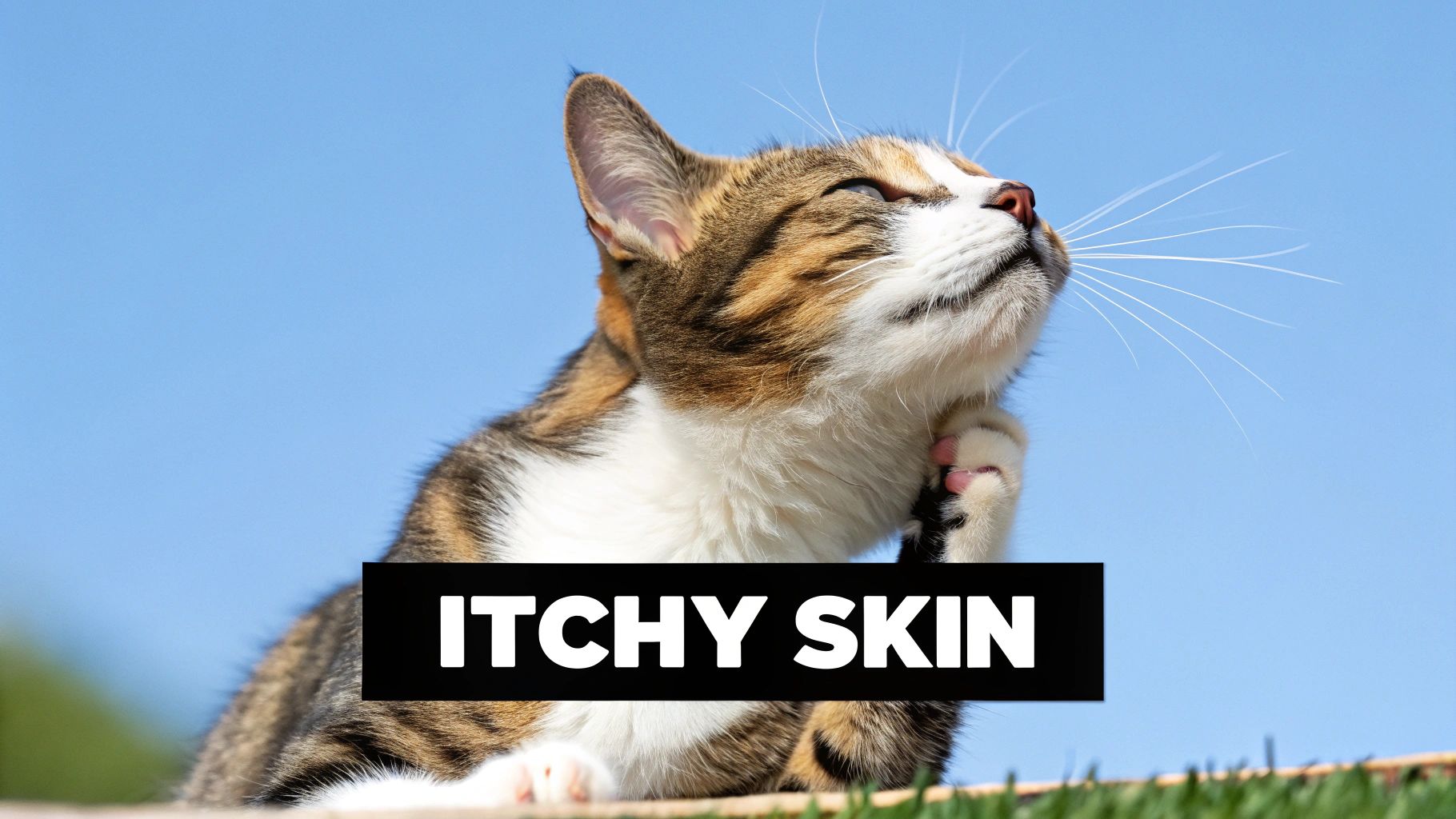
While an upset stomach can definitely be a clue, the most telling signs of a food allergy in cats are almost always written on their skin. Imagine wearing an itchy wool sweater that you can never, ever take off. That's what your cat might be dealing with, and that constant discomfort leads to more than just a simple scratch.
You'll probably notice your cat scratching relentlessly, especially around their head and neck. This isn't a casual itch—it's a persistent, sometimes frantic effort to get some relief. In fact, studies show that intense itching focused on the head and neck is a classic sign, affecting anywhere from 30% to 65% of cats with food allergies. You can get more details from these insights on feline pruritus.
Beyond the Itch: Common Visual Clues
All that scratching and licking quickly spirals into more visible problems. It’s important to keep an eye out for these red flags, as they show the irritation is getting worse.
Some of the most common signs include:
- Self-Induced Hair Loss: You might see bald patches on their belly, inner thighs, or legs from over-grooming. A cat's tongue is like sandpaper, and it can easily pull out fur as they try to soothe their itchy skin.
- Miliary Dermatitis: This condition feels like tiny, crusty scabs across your cat’s skin. You'll often find them concentrated on their back, neck, and head, and you might not even notice them until you pet your cat and feel that bumpy texture.
- Sores and Lesions: In more serious situations, non-stop scratching can break the skin, leaving behind open sores, redness, and inflammation. These raw spots are a prime target for secondary bacterial or yeast infections.
It's a frustrating cycle: the allergy causes the itch, the scratching damages the skin, and that damage invites infections that only make the itching more intense.
To help you distinguish between a minor irritation and a more urgent problem, here’s a quick guide to common skin symptoms.
Common vs. Severe Skin Symptoms in Feline Food Allergies
| Symptom Area | Common Signs | Severe Signs (Consult a Vet) |
|---|---|---|
| Overall Skin | Mild, occasional scratching; dry or flaky skin. | Constant, frantic scratching; widespread redness or bumps. |
| Head and Neck | Itching around the ears and chin. | Open sores, scabs, or bleeding from aggressive scratching. |
| Coat and Fur | Thinning fur in some areas; excessive shedding. | Obvious bald patches; greasy or matted fur. |
| Belly and Legs | Licking the area more than usual. | Raw, inflamed skin ("hot spots"); signs of infection (pus). |
Recognizing these severe signs is your cue to call the vet. They can help manage the immediate symptoms and get your cat on the path to feeling better.
Pinpointing which ingredients are causing the trouble is the only way to truly break this cycle. To get a head start, check out our guide on cat food ingredients to avoid. Remember, those secondary infections and raw sores are clear signs your cat needs a veterinarian to treat both the skin damage and the allergy underneath it all.
Recognizing Allergy-Related Digestive Upset
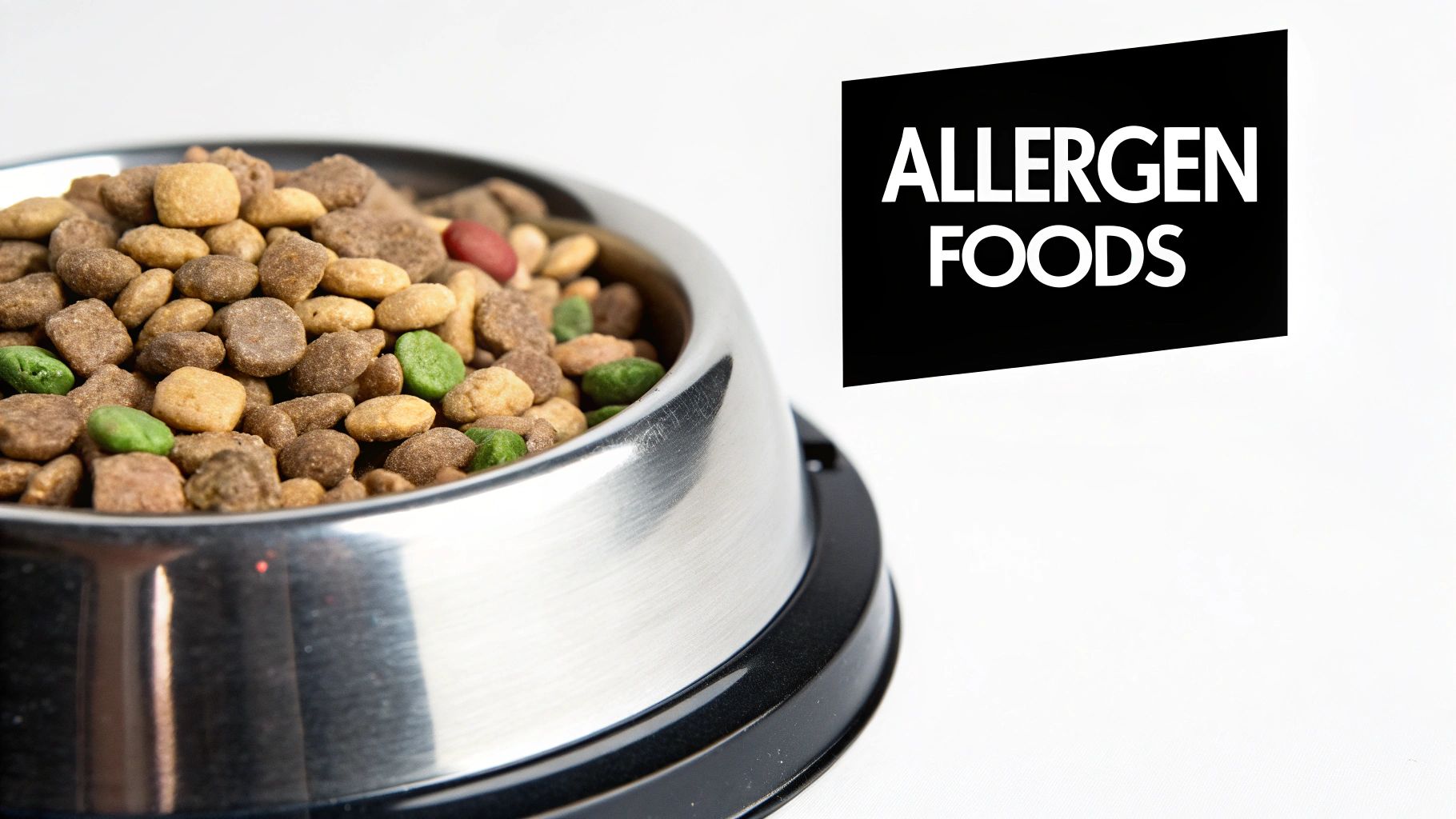
While itchy skin is the most visible billboard for a food allergy, what’s happening inside your cat’s body is just as important. An immune system overreacting to a food ingredient doesn't stop at the skin—it can throw the entire digestive tract into chaos.
Think of it as a fire alarm going off in their gut every single time they eat the offending food. This constant state of alert creates inflammation all along their gastrointestinal (GI) tract, leading to symptoms that are far more than just a simple tummy ache.
From the Bowl to the Bellyache
It’s easy to write off a little vomiting as just a hairball, or some soft stool as something they ate. But when these issues stop being a one-off and become a chronic problem, they are often screaming signs of food allergies in cats.
The ongoing inflammation disrupts how the gut is supposed to work, and this is your cat’s way of letting you know something in their bowl just isn't agreeing with them.
Keep an eye out for these persistent digestive red flags:
- Chronic Vomiting: We're not talking about the occasional hairball. This is regular vomiting, often after meals, with no other clear explanation.
- Persistent Diarrhea or Soft Stools: Consistently loose stools are a dead giveaway that there's intestinal inflammation, and it’s a very common symptom in cats with food sensitivities.
- Increased Gas (Flatulence): It can be subtle in cats, but if you notice more gassiness than usual, it can be a sign their digestive system is in distress.
- Signs of Abdominal Pain: Is your cat suddenly tensing up when you go to pick them up? Are they hunching over or avoiding being held? This could be a sign of belly pain.
It's crucial to understand that these digestive problems aren't separate from the skin issues. They are all part of the same immune response. The allergenic protein triggers a full-body reaction, affecting your cat both inside and out.
In fact, it's estimated that around 30% of pets with food allergies also suffer from gastrointestinal symptoms. This really drives home the powerful link between diet and gut health. Finding the trigger ingredient is the only way to bring them relief. A good starting point is learning about the best cat food for a sensitive stomach, which can offer gentler options while you and your vet investigate.
Trying to figure out what's making your cat so itchy can feel like a real head-scratcher. The tricky part is that the problem might not even be what's in their food bowl. Environmental allergies, often called atopy, can cause the exact same frustrating skin problems as a food allergy.
Think of it this way: you know your cat is reacting to something, but is it the chicken in their kibble or the pollen wafting in through the window? Both culprits can lead to the same result—a miserable, itchy cat.
Playing Detective: Food vs. Environment
While only your vet can give you a definite answer, you can start looking for clues at home. One of the biggest hints is timing. Do your cat's flare-ups seem to follow a pattern? If they're scratching like crazy every spring but seem fine in the winter, you might be looking at a seasonal environmental allergy.
A true food allergy, on the other hand, usually causes problems year-round because the trigger ingredient is in their daily meals. But here's where it gets complicated.
The real challenge is that many cats have both food and environmental allergies. One can easily make the other worse, creating a perfect storm of itchiness that's tough to untangle. This overlap is precisely why getting a vet's help is so important.
Plus, common environmental allergens are everywhere. Proteins that trigger allergies in some cats, like Fel d 1, are found in dust and public spaces, even where there are no other cats. So, a cat with a mild food allergy might suddenly get much worse just from exposure to something in the air. You can learn more about how environmental allergens affect cats from recent studies.
Ultimately, your veterinarian will need to conduct a proper investigation. This almost always starts with a strict elimination diet to see if food is the primary cause, effectively ruling one of the main suspects in or out.
The Vet's Approach to a Definitive Diagnosis
If you suspect your cat has a food allergy, your veterinarian will need to put on their detective hat. Interestingly, the tools they use for this are quite different from what you might expect. Blood tests and skin patch tests, which work well for environmental allergies, are notoriously unreliable for pinpointing food sensitivities in cats.
Instead, the veterinary world relies on a tried-and-true method that's considered the gold standard: the dietary elimination trial.
How a Food Trial Works
Think of an elimination trial as a careful food investigation. The entire goal is to remove all potential triggers and see if your cat's symptoms clear up. Your vet will prescribe a special therapeutic diet for a strict period, usually lasting 8 to 12 weeks.
This process is all about hitting the reset button on your cat's immune system. To do that, the prescribed food has to be something completely new to their body. Vets typically go one of two routes here:
- A Novel Protein Diet: This involves feeding a protein source your cat has likely never had before. Common options include venison, duck, or even rabbit. If the immune system has never seen it, it can't react to it.
- A Hydrolyzed Protein Diet: This is the high-tech option. In these diets, the proteins are broken down into molecules so small that your cat's immune system doesn't even recognize them as potential allergens, effectively sneaking them past the body's defenses.
The absolute number one rule for an elimination trial is 100% compliance. Your cat can eat the prescribed food and only the prescribed food. That means no treats, no nibbles of your food, no flavored toys or medications, and definitely no hunting. A single slip-up can skew the results and force you to start all over again.
This process—from the initial trial to reintroducing old foods—is the only way to get a real answer.
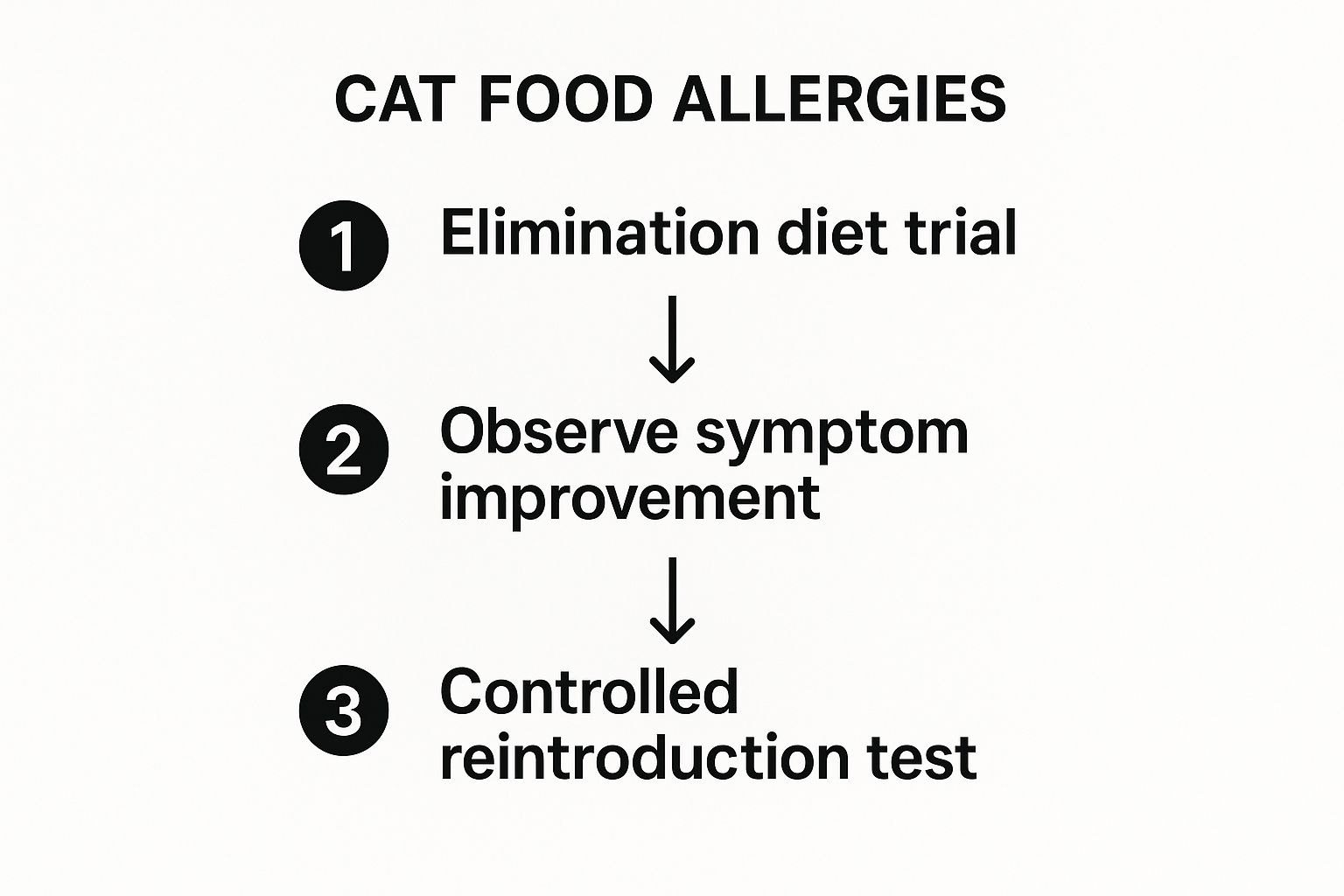
If your cat's itchy skin or upset stomach dramatically improves on the new diet, you're on the right track. The final step is what's called a "challenge." You'll carefully reintroduce the original food under your vet's guidance. If the symptoms come roaring back, you've found your culprit and can finally build a long-term diet plan for a happier, healthier cat.
Common Questions About Cat Food Allergies
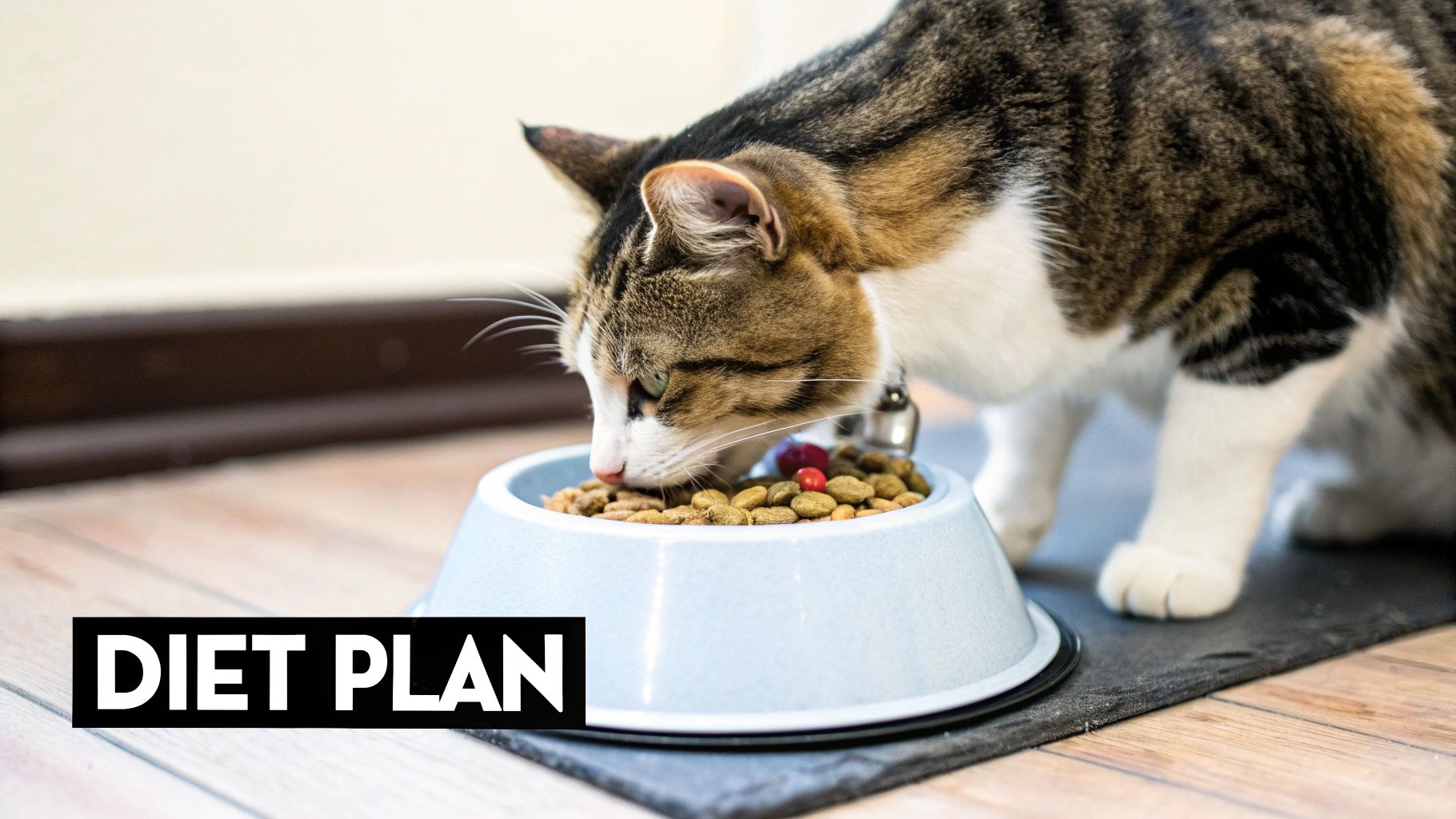
When you suspect your cat has a food allergy, the questions start piling up fast. It can feel confusing and overwhelming, but getting straight answers is the first step to helping your little companion feel better.
Let's walk through some of the most common things cat owners ask. Clearing these up will help you partner with your vet to crack the code on your cat's dietary needs.
Can My Cat Suddenly Develop an Allergy to Their Long-Time Food?
Absolutely. It seems strange, but this is actually how most food allergies develop in cats. It’s not an immediate reaction to a new food; it’s a sensitivity that builds up over time to a familiar one.
Think of it like a dripping faucet. For years, your cat can eat the same protein—say, chicken or fish—with no issues. But behind the scenes, their immune system can slowly start to flag that protein as an invader. Eventually, the faucet overflows, and you start seeing the classic signs of an allergic reaction.
What Foods Most Commonly Cause Allergies in Cats?
While any food can technically cause an issue, we definitely see a few usual suspects pop up again and again in veterinary practice. The culprits are almost always the most common proteins found in commercial cat foods.
The top offenders include:
- Beef
- Fish
- Chicken
Dairy is another big one for some cats. The common thread here is prolonged exposure. The more your cat eats a certain ingredient over the years, the more opportunity their immune system has to develop a sensitivity to it.
This is a crucial point: food allergies are typically a response to a protein your cat has been eating for a long time, not something they just tried for the first time.
Will a Grain-Free Diet Fix My Cat’s Food Allergy?
Probably not. This is one of the biggest myths out there. While it's a popular marketing angle, genuine grain allergies are actually quite rare in cats compared to allergies to animal proteins.
If your cat's immune system is reacting to the chicken in their food, switching to a grain-free chicken formula won't make a bit of difference. The real solution lies in figuring out the specific protein trigger and removing it entirely. That’s why a proper elimination diet trial, guided by your vet, is the gold standard for getting to the root of the problem.
At Joyfull, we believe in clean ingredients and high-quality proteins because a healthful life isn’t just for humans. Explore our scientifically reviewed formulas to find a better-for-you option for your pet at https://joyfullpet.com.
